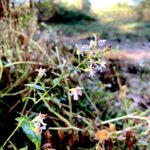
Photos by Jeffrey North Lone Tree Hill is a popular spot for a springtime stroll—but Belmont’s open space offers fall fascination as well. From asters to mountain mint, the site’s native plants put on a colorful autumn show.
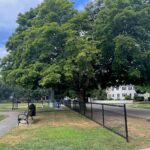
By Vicki Amalfitano, Lucia Gates, Eva Hoffman, and Adam Howe What makes you feel at ease when you drive down a town street? Would it be as comfortable on a hot summer’s day without shade trees? Tall, beautiful oak, maple, and birch trees; magnificent beech trees, flowering dogwood, magnolia, and cherry trees enrich our streets and yards. They fill our senses with their beauty, and they cool our homes. They take in the carbon dioxide we breathe out, and they release the oxygen we breathe in. We are grateful for the trees’ benefits and their positive impact on the value [READ MORE]
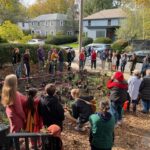
An abridged version of the article appeared in the July/August 2024 BCF Newsletter. Group Plants Front-Yard Forest in Cambridge By Susan Filene, Tori Antonino, Judy Perlman, and Ali Kruger The first Miyawaki forest in the northeast was planted on public land in Cambridge in September 2021. (Miyawaki Forest Boosts Biodiversity, Resilience, BCF Newsletter, May 2022). Similar little forests have been planted or are planned for nearby communities, including Somerville, Brookline, Watertown, Natick, and Worcester. It occurred to me that people could do something similar, on a smaller scale, in their urban/suburban yards. We could replace lawns with native species of [READ MORE]
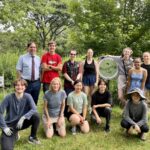
by Jean Devine An open mind, eagerness to learn new things, a willingness to work with peers from different schools, and a tolerance for hot weather, a bit of rain, and getting dirty are all it takes to be a Biodiversity Builder. Youth don’t join Biodiversity Builders (BB) to fill out their resume. They join because they’re curious about nature and maybe gardening, they worry about climate change, and they want to do something positive to help the planet. Youth who become Biodiversity Builders learn how to solve environmental and societal challenges, get down and dirty removing invasive plants and [READ MORE]
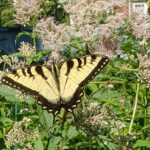
By Judy Sheldon Whether we’re growing tidy-looking lawns, tree-lined paths to meander, or flower or vegetable gardens, our yards and our parks also provide food and shelter for other creatures. Bees, butterflies, ladybugs, spiders, and fireflies all live in our lawns, gardens, and trees. Birds eat the seeds, berries, fruits, and nuts from the plants. Some bird species get nutrients from insects, including mosquitoes and others we don’t want around. Rabbits eat mostly plants; squirrels and chipmunks thrive on fruits, nuts, and acorns. Larger birds, like hawks, owls, and even eagles, also eat the small animals and birds that live [READ MORE]
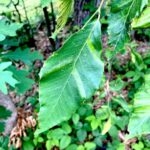
By Phil Perron The majestic beech tree is under attack in Massachusetts. The culprit is a microscopic nematode (Litylenchus crenatae ssp. mccannii). Beech leaf disease (BLD) has taken the state by storm, causing, in the best cases, leaf distortion and, in the worst cases, total tree mortality. All beech tree varieties are at risk, including the stately copper beech. Unfortunately, many questions about this disease have yet to be answered as the industry works to find solutions to manage this pest before it is too late. BLD was first discovered in Ohio in 2012. Eight years later, it had made [READ MORE]
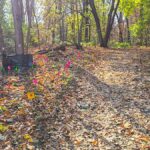
By Radha Iyengar Belmont’s Lone Tree Hill Conservation area benefited from another year of conservation, restoration, and stewardship, thanks mainly to the efforts of the Land Management Committee for Lone Tree Hill (LMC). Many Belmontonians and visitors enjoy this 119-acre conservation property for walking, biking, viewing wildlife, and being out in nature. The LMC was created through a memorandum of agreement between the town and McLean Hospital in 1999. The agreement outlined the development restrictions for the McLean Hospital campus. It also reserved approximately 119 acres of the campus as publicly accessible open space, including a new municipal cemetery, and [READ MORE]
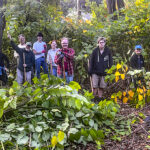
By Vincent Stanton, Jr. and Pamela Andrews Belmont Conservation Volunteers (BCV) formed earlier this year to work on “restoring our natural spaces for everyone to enjoy.” Volunteer efforts have focused on reining in the extensive and expanding invasive species displacing native plants which support local insects, birds, and mammals. The BCV emerged from pioneering volunteer work by Leonard Katz on Lone Tree Hill. (See “Spare a Thought for Lone Tree Hill”, BCF Newsletter, September 2022.) To expand that work to town-owned land, Katz and Sustainable Belmont leader Dean Hickman obtained permission from both the Select Board and, because many of [READ MORE]
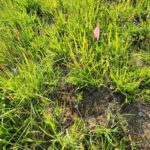
By Jeffrey North On Earth Day 2023 (April 22), the Belmont Citizens Forum (BCF), in conjunction with the Judy Record Conservation Fund, held its ninth annual Lone Tree Hill Volunteer Day. (See “Volunteers Plant, Clean Up Lone Tree Hill,” BCF Newsletter, May/June 2023, for more information). Several dozen volunteers rolled up their sleeves, and gardening trowels in hand, planted 350 plugs of young native plants in the Great Meadow and reclaimed meadow areas of Belmont’s Lone Tree Hill Conservation Land in addition to planting 40 white pine saplings to replace the mature pines gradually lost to age and weather. The [READ MORE]
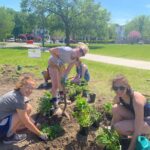
By Audrey Brenhouse On Saturday, May 13, the Belmont High School Climate Action Club, with the help of adult and student volunteers, planted our long-anticipated native garden in front of the school. Our goal is to grow plants native to this area to promote and support native wildlife, helping to restore the land’s natural biodiversity. In the spring of 2022, we held a student-led concert where many families kindly donated to this process. After years of approvals and fundraising, we are proud and grateful to be able to display the result of your generosity. Over the next few years, these [READ MORE]
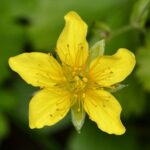
By Sarah Wang, Kim DeAndrade, and Jean Devine By this point in the summer, your water barrels may be dry and you may be devoting inordinate amounts of time (and money) to watering. No matter how much you water, it cannot compare to real rain. Here are some tips to help with drought: Mulch! Besides retaining moisture, mulch will feed the soil and keep down the weeds. Avoid dyed mulch. It is unregulated and may contain shredded construction wood waste and pressure-treated wood. And, it won’t do much to feed the soil. If you buy mulch, consider compost and [READ MORE]
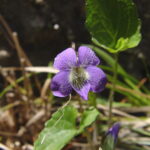
By Heather Pruiksma Spring has sprung, and gardeners everywhere are itching to get their hands into the soil and among the roots. At Grow Native Massachusetts, we encourage including more native plants in your gardens, which can be less work than it might seem — if you’re willing to be a little patient. Native plants are plants that have been growing in a particular habitat and region, typically for thousands of years or much longer. Also called indigenous, they are well adapted to the climate, light, and soil conditions that characterize their ecosystem. Within this system, they have evolved important relationships [READ MORE]
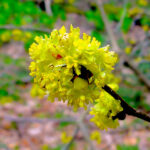
By Meg Muckenhoupt May is the peak of spring migration season in Massachusetts, and thousands of birds are landing in Belmont. (You can even get radar reports on which birds are arriving overnight on birdcast.info.) But what will these birds do when they get here? Will they find the resources they need to survive, raise young, and embark on fall migrations next September? The answer may depend on what’s growing around Belmont—and a lot of what’s growing around Belmont is invasive plants. Plants change birds’ lives North American birds evolved with native plants. Most bird-lovers know that different types of [READ MORE]
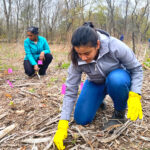
By Radha Iyengar The Belmont Citizens Forum (BCF), in conjunction with the Judy Record Conservation Fund, held its ninth annual Lone Tree Hill Volunteer Day on Saturday, April 22, an overcast and cool day. Volunteers included Girl Scouts Troop 82027, employees of Cityside Subaru, M&T Bank,and the Sai Group, and residents of Belmont and the surrounding communities. Many hands made light work. At the Pine Allee, efficient volunteers planted forty white pine saplings. The new plants replaced the Allee’s missing trees and some of the dead saplings from previous volunteer day plantings. At the adjacent meadow the volunteers planted slender [READ MORE]
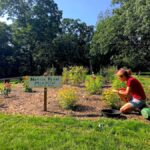
By Elissa Ely There were woods behind Jean Devine’s house growing up in Manchester, New Hampshire. As a child, she liked pressing leaves and hated wearing socks; her mother would send her outside on ‘safaris’ with apple slices, the family dog trailing behind. She was always late to school. Jean was unafraid of bugs and fascinated by Daddy Longlegs. Woods and spiders did not turn her into the environmental educator, native-plant coach, and landscaper she eventually became, but they were her introduction to nature. Her mother belonged to the Garden Club in an era when plots were visually beautiful, organized [READ MORE]
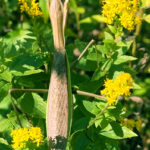
By Jeffrey North In 2020, the Land Management Committee for Lone Tree Hill (LMC) and the Judy Record Conservation Fund began a multi-year campaign to restore native plant communities in prioritized areas of the Lone Tree Hill conservation land. Step one in the restoration was to bring the invasive plant species under control. Planting natives would be a wasted effort and expense if they cannot compete with the pernicious plants that have come to occupy large swaths of our conservation lands and private yards. The work began with a broad brush, property-wide restoration survey conducted by ecological design professionals in [READ MORE]
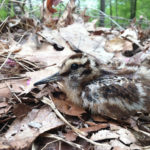
By Joseph Hibbard and Jeffrey North The Belmont Citizens Forum Newsletter has been printing articles about the perils and poisons of non-native invasive plant species on these pages for years. Readers have learned that garlic mustard changes the chemistry of the soil to gain an advantage over other plant species in forest and edge areas. Our article on black swallowwort described that plant’s deadly toxicity to Monarch butterfly larvae that mistakenly consume it instead of nourishing native milkweed. We have described how Asiatic bittersweet rapidly climbs native trees, blocks the sunlight, and eventually topples the tree while changing our viewsheds. [READ MORE]
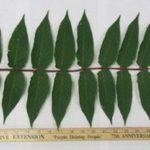
By Jeffrey North Tree-of-heaven (Ailanthus altissima), typically called ailanthus, is a rapacious deciduous tree native to China. It was first introduced into the United States when it was imported as an ornamental plant to Philadelphia in 1784 and later to New York in 1820. On the West Coast, immigrants brought the plant from Asia and planted it in California in the 1850s. The tree was initially valued as a fast-growing ornamental shade tree that was tolerant of poor soils and a broad range of site conditions. It tolerates vehicle exhaust and other air pollution quite nicely. It was widely planted [READ MORE]
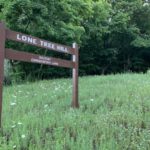
By Dean Hickman and Leonard Katz Between Pleasant Street and Trapelo Road to the south, Concord Avenue to the north, and Mill Street to the west, Lone Tree Hill wraps around McLean Hospital and sits above Belmont, providing us with a peaceful and secluded mix of woods and meadows where we can escape the hustle and bustle of suburban life down below. It is also Belmont’s gateway to Rock Meadow on the other side of Mill Street as well as to the more secluded trails of the Western Greenway which head west into neighboring Waltham and Lexington. Anyone looking for [READ MORE]
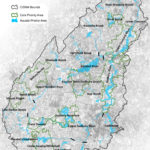
By Jeffrey North New York state has eight very large ones. Oregon has 10. Michigan has more than 20 (required by law for every county). The number of Comprehensive Invasive Species Management Associations (CISMAs) across the country is approaching 400. Massachusetts has one. But that number is likely to increase. With the likely passage of the invasive species bill (H4595), financial and administrative resources will be available for CISMAs and a host of other programs, plans, and projects for controlling invasive plants. The bill would establish an invasive species trust fund. A statewide invasive species coordinator would be appointed, along [READ MORE]